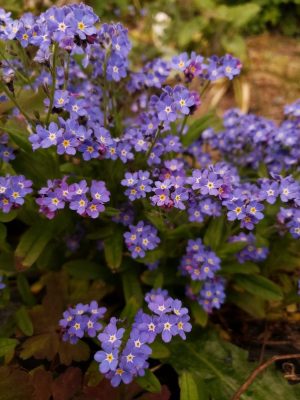Natural weed control and heirloom flowers in the garden. Can I get an amen? How to create beauty using flowers, not only in your homestead flower beds, but also in the vegetable garden so that you can create a haven wherever you look on your homestead.
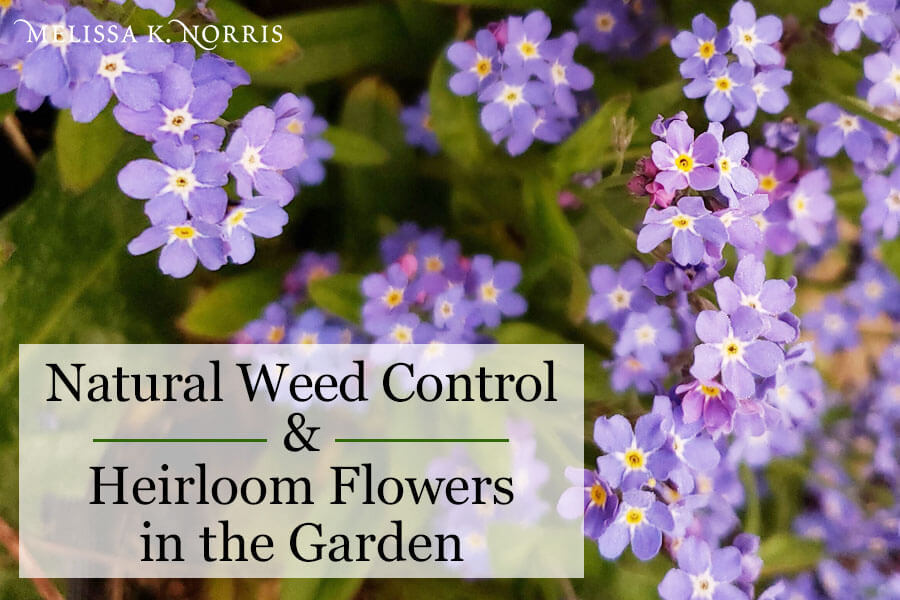
I do not have a ton of experience with flowers. The way that I grew up and the way that we have gardened for decades now has been mainly focused on food production. But about two or three years ago, I really decided that I wanted to bring in more beauty by adding flowers to our homestead.
Now some of those flowers are edible or have medicinal purposes. But I made it a goal that things didn’t need to have the sole purpose of feeding us or providing us with medicine in order to have a home on our homestead; They could just be for the pure pleasure of enjoying their beauty.
That being said, I am so excited to introduce today’s guest, who definitely knows a thing or two about bringing beauty to her own homestead. Welcome Shaye Elliott from The Elliott Homestead.
Shaye: Thank you so much. It’s great to be here.
Melissa: I thought it would be fun today to start off by talking about some of the things that we’ve both learned throughout the years and throughout many gardening seasons when it comes to taking steps now to help make the workload easier down the road.
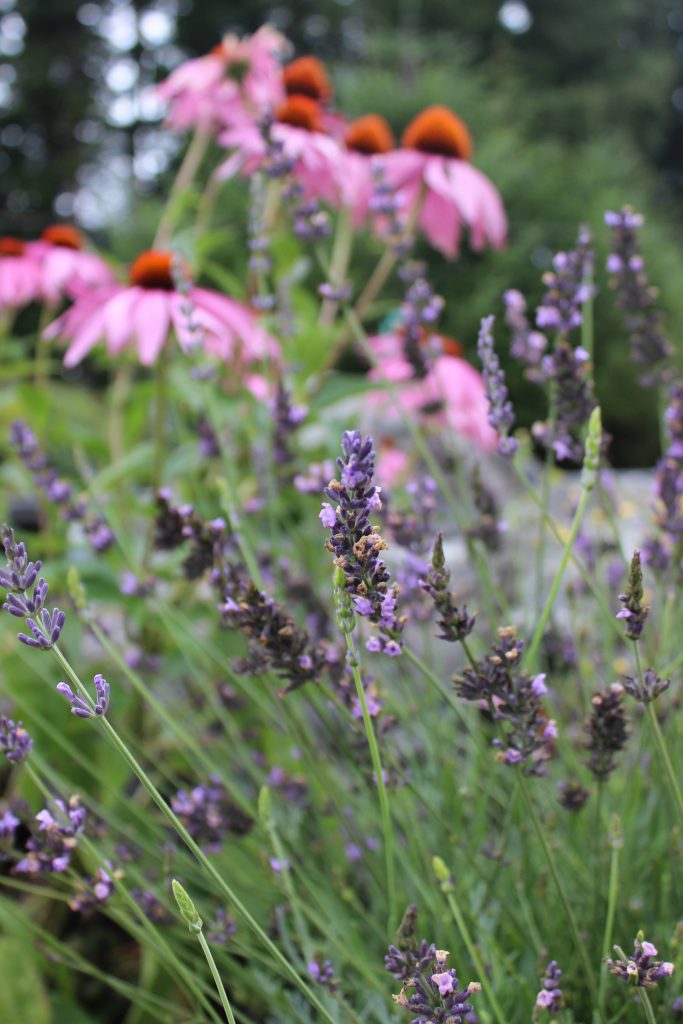
Natural Weed Control
Shaye: Looking back, probably one of my biggest mistakes was not doing more to prevent weeds from popping up all over. I think I kind of held onto the idea of being a purist in the garden before, so I rejected using weed tarp. It sounds so silly to say, but man, I would’ve saved myself some serious work in the past.
I have a little potager-style garden right off of my kitchen. It’s a traditional French style of garden that incorporates some flowers and some vegetables, and it’s meant to be functional but also decorative. So this isn’t where we grow our huge market crops or anything. It’s really just a big rectangle patch of dirt. And man, I was out there weeding that thing from sunup to sundown basically all summer.
And so as I stared at it this year, I thought it would actually be really helpful to create pathways and put down weed tarp and mulch and save myself the backbreaking work of weeding all summer long.
Melissa: Yes, I’ll be doing a lot more mulching than I have done in years past to help suppress the weeds, but also to retain moisture.
We’ve had drought conditions for the past three summers, even here in the rainy Pacific Northwest. We’ve actually broken the record for the longest drought, three summers in a row. So I am really looking at using a lot more moisture control methods than I ever have in the past. I’m looking at putting in a lot more mulch this year in our vegetable garden.
Shaye: Oh yeah. Mulch is incredibly helpful. That was kind of the stepping stone for us. Then going to the weed tarp and the mulch.
When it comes to the moisture retention, last summer we saw rain in May and we didn’t see rain again until September. So we literally went all summer without any precipitation. Luckily we have a, well so we could irrigate our gardens, but mulch was absolutely essential for keeping the soil workable and moist.
Weeds: An ounce of prevention is worth a pound of cure
When we learned how to garden with mulch, that was probably one of the biggest steps we took in terms of seeing success in the garden just because of the weeds and the moisture. And then eventually it breaks down and feeds the soil too.
The weed tarp has been really helpful for us too. We have gravel pathways that sort of weave through our flower beds and through our vegetable gardens. So we put a weed tarp under there and then put gravel on top, which actually acts like a mulch. So that’s really helpful for the pathways.
But when it comes to weeding, you kind of just have to do the hard thing sometimes. You have to just get on your knees and get out your little trowel, take your bucket and just spend time weeding.
There are always going to be weeds. There’s always going to be something that needs to be done in the garden. And part of becoming a gardner is learning to love that process.
I use it as a time of therapy. I get my espresso, maybe I listen to a podcast or a book on audible, whatever it is. Maybe it’s silence. But I just get to sink in and do the hard thing without being too overly simplistic about weeding. You can only manage it to a point and then you’ve just gotta do it. Is that terrible news?
Melissa: Not really. I mean, you can do a lot of weed suppression, either using cloth, or you can use cardboard layers of newspaper and then put some type of mulch on top. But there is no such thing as a weed-free garden, and there will always be some type of actual manual weeding to be done.
Honestly though, if you just do 15 minutes a day, you’ll be surprised at how quickly that adds up. I think a lot of times we look at something and we become overwhelmed and we build it up in our mind as a lot worse than it actually is. But if you just start to dive in and do the thing, you’re going to realize it really isn’t that bad.
Shaye: I think that’s a great point. It’s like laundry. If you don’t do laundry for two weeks, all of a sudden you’re looking at 30 loads of laundry. (I have a lot of children. It’s always like 30 loads of laundry). But if I wash two or three loads a day, it’s fine.
My kids, they’ve also learned now which ones are weeds. Because many a sweet little flower has been lost to little hands that overzealously helped.
Melissa: Yes, I get my kids to help too. Since they’re a bit older now, I’m like “okay, if you do so many minutes of weed pulling, you get so many minutes of electronic time” or whatnot. So it’s kind of a really good trade off.
Shaye: Definitely. Another great weeding method is conning your children.
How (and why) to add flowers to your vegetable garden
Melissa: I do want to come back to the flowers because like I said, I’ve just really started putting in lots of flowers in our vegetable garden and stuff. And so tell me a bit about the style that you use when choosing your varieties and where to plant what.
I know you use a layering method with some of your flowers and that type of thing. So talk to us a little bit about that method.
Shaye: So, my affinity for flowers started because I worked at a floral shop throughput high school and college. And even actually through first the first few years of our marriage. So I knew a lot of flowers once I finally decided to grow them. I knew a lot of the names that I was looking for. But what that basically translated to is just going to Lowe’s and just being like, oh I know that flower, I know that flower and then putting them in and hating it. Then I’d pull them all out and start again.
It does take a little bit of time to find your style, but our style of flowers now is very relaxed, very cottage style.
I don’t know if your listeners are familiar with Tasha Tudor, but Tasha was a children’s book illustrator who lived on the east coast and she grew amazing cottage gardens and and did most all the work herself and she was fantastic. Her book, Tasha Tudor’s Garden, is still available here. She was the one who kind of introduced me to this idea. She’s passed away now, but her books introduced me to this idea of your garden really looking beautiful all year round. Whether or not something is blooming.
Then on top of that there came a new book called The Layered Garden focused around the same sort of a concept that you need to think about what you’re planting in an area and what will be there in winter, what will be there in spring, what will be there in summer.
The idea is to ask yourself, what’s going to come next to this area?
Because what I had found is I had built my gardens in a way, let’s say with a bunch of tulips and daffodils, which look beautiful in the spring. But then those fade. What is then planted as the next layer in that same spot to be the next thing that comes forward. And when that passes after summer, what’s going to be the next thing to come up in the fall?
Or what structure is there? Maybe it’s a red twig dogwood or maybe it’s just some sort of architectural feature like a trellis or a rusty wheelbarrow. Whatever your style is, what’s going to be there to bring interest to that space through each of the seasons. And basically what this translates to is the gardener planting essentially four or five or six gardens in one, which sounds like a ton of work, but it’s really not.
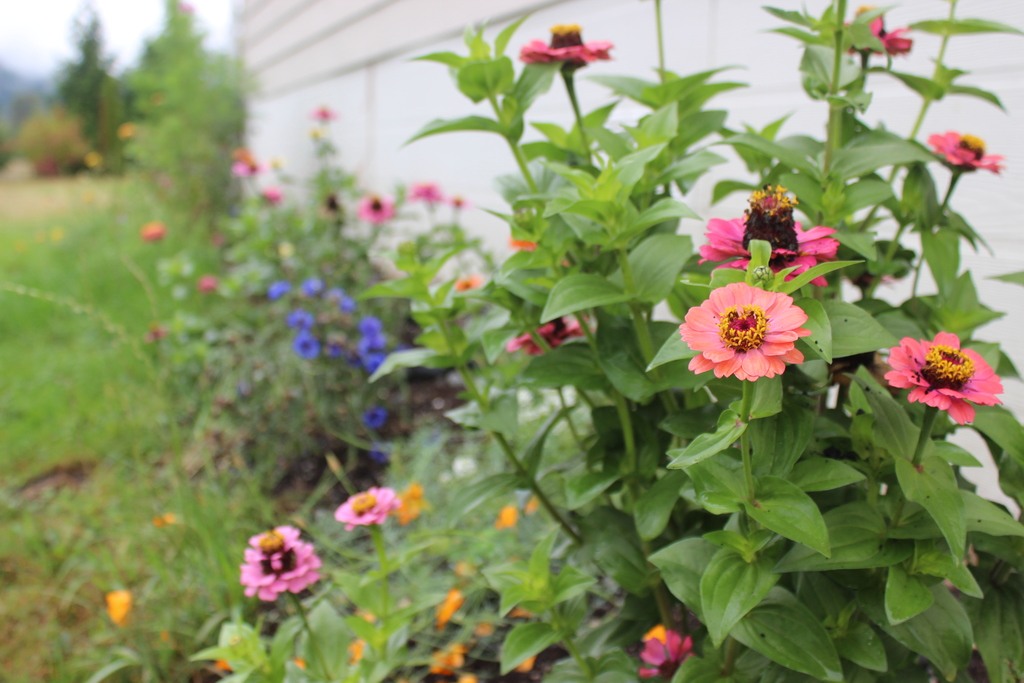
So for example, my tulips and daffodils… A great way to bring interest to that area in the summertime is just to sow some Zinnia seeds. You can plant Zinnia seeds right over the tulips and daffodils so that when those fade, you instantly have this huge hit of annuals coming on. And then when those plants fade in the fall, then you can think about the structure beyond that. So it’s a really interesting method. There’s always something new and exciting coming.
Heirloom Cottage Flowers
But our garden is not like a stuffy Victorian state garden. I want it to feel comfortable, so things like:
- Black Eyed Susans
- Lady’s Mantle
- Hardy Geranium
- Lupin
- Calendula
Those are a lot of things that will actually self-seed and sort of naturalize. Sometimes you have to kind of dig them up and put them where you want them, but you know, it’s a great way to basically get free perennials and to kind of get that more natural layered look, depending on what your style is in your garden.
Melissa: Yeah, I’m definitely not a super manicured type. I love fields of wild flowers and just like little secret pops of flowers all over. I love it when you’re just, you know, walking out and you just happen to see there’s a little pot of flowers, you’re like, oh my goodness. Where did that come from? Just, yeah, very natural.
So I am curious though, especially with the bulbs, so you’ve got bulbs like irises or daffodils and tulips, and then you seed the Zinnias or another type of annual because they’re growing in essentially the same spot. Do you have to fertilize more or do you use more compost or did they just seem to be just fine or how does that work when you’ve got multiple things growing in the same spot?
Heirloom flower bed health and care
Shaye: I am very unsystematic about such things. We have a little small farm, so we have a dairy cow, we have sheep, we have rabbits, we’ve got chickens… All of this is to say we literally have every type of manure we could possibly work, and we have a lot of it. So we just continually scrape the animal manure and build this gigantic compost pile.
I layer on as much as I can physically muster every fall and first thing in the spring, as soon as the snow melts. And that’s what, that’s all I do. I don’t measure it. I have no idea. I don’t test it for anything. I never adjust my soil, I’m like the worst gardner in terms of fallowing any kind of rules.
But I do add aged animal compost to all of my beds, vegetable and flower, twice a year. And then we always keep our flower beds mulched.
Whether you use leaves or straw or grass or bark, flowers like to be kept moist. They like nutrients that break down in the soil. The worms like protection from the sun. So all the same things that our vegetables benefit from, your perennial flowers really enjoy the same thing. Good compost, good mulch, consistent watering, you know, all the normal stuff.
Melissa: Okay, I have a feeling I’m going to be filling shopping carts full of flowers to bring home.
Shaye: It is like a serious, serious problem. It’s a real sickness, but I always tell my husband, it’s not drugs, so you kind of can’t get angry.
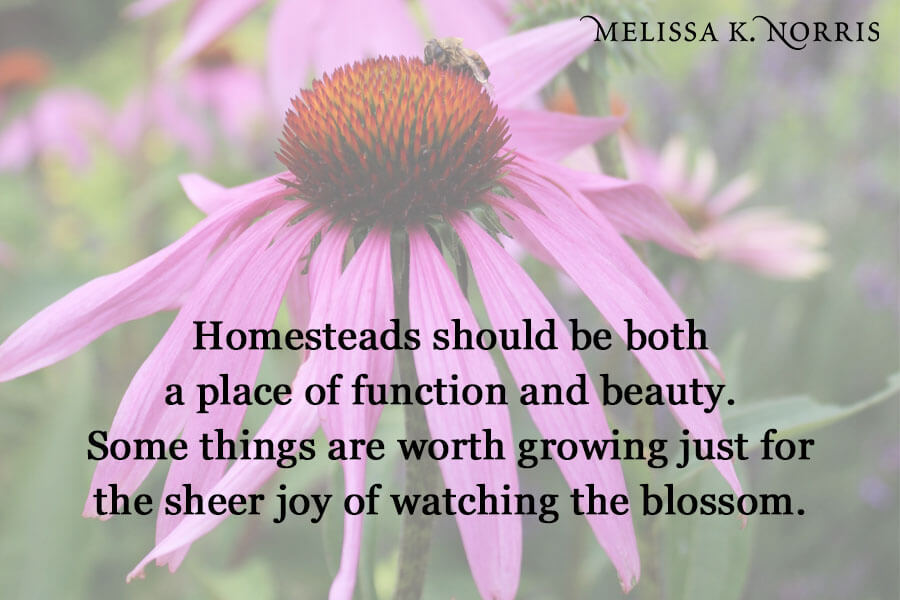
Melissa: Right! And it’s not shoes. Like I know you’ll hear a lot of women say like they have a shoe addiction. I’m like, no, here it’s seed catalogs!
A homestead doesn’t have to be ugly
Shaye: You know, we moved into this house three years ago. We still have a lot to do, but when we first moved in I kind of got the, “are you crazy?” look when I was like, “we’re going to have a garden here and then this area will be for this…”
We have spent the last three years just in deep labor, working ourselves to the bone to create this area. But now that we’re three years in, you know, when spring came and the perennials started to come up and a lot of the bones of the gardens were in place, there were many moments where we looked at each other and we thought “this was totally worth it.”
I don’t think that homesteads, you know, whether you’re growing vegetables, whether you have animals, whatever it is, it doesn’t have to be ugly.
I don’t know why we feel like if we have animals or if we’re growing purely for production, that things can’t be beautiful. I think flowers are such a wonderful way to add that. Just layers of enjoyment and beauty for beauty’s sake to enjoy our outdoor spaces.
Melissa: So do you have any favorite places that you go to shop for flowers?
Choosing flowers for your homestead
Shaye: Actually, Tasha Tudor, that gardener I mentioned, she’s passed, but her family still does a little seed sale every year and they fell seeds from some of her heirloom plants that she grew. So I’ve gotten a few from there, which are just prized possessions to me because her gardens are the reason I have my gardens.
Blue Stone Perennials is another great resource online. They’re a little pricey, but I will tell you my gardens that I have started exclusively with Bluestone Perennial flowers are exquisite. And part of that is because you get a huge array of things to choose from that you just can’t get anywhere else.
You can really piece together your whole garden from a site like that. And then you know, layer in some things that you can get for cheaper at Lowes or somewhere. Even if you go to someplace like Bluestone and you just pick out 10 plants that you want to introduce to your garden instead of picking out 40 different ones that you kind of like, narrow it down and order those 10 plants en masse.
You’ll see your garden take shape a lot quicker and it’s going to have a much bigger impact. So for example, you could buy dozens of Forget Me Nots starts and a dozen Apricot Beauty Foxgloves and layer that with a nice David Austin Rose and you’re going to have an instant show that first year. Whereas if you just buy one of each little thing from all of your different nurseries, you’re never going to get that wow factor that you really want.
Melissa: I’m going to totally be getting an order placed super fast before it gets too late in the planting season. I’m super excited and just so you know, when all these boxes show up and my husband is like, “what are you doing?” I’m going to totally say Shaye made me do it.
Book Giveaway
Win a copy of my book Hand Made: the Modern Guide to Made-from-Scratch Living and Shaye’s book, Seasons at the Farm, by entering our giveaway here on Instagram!
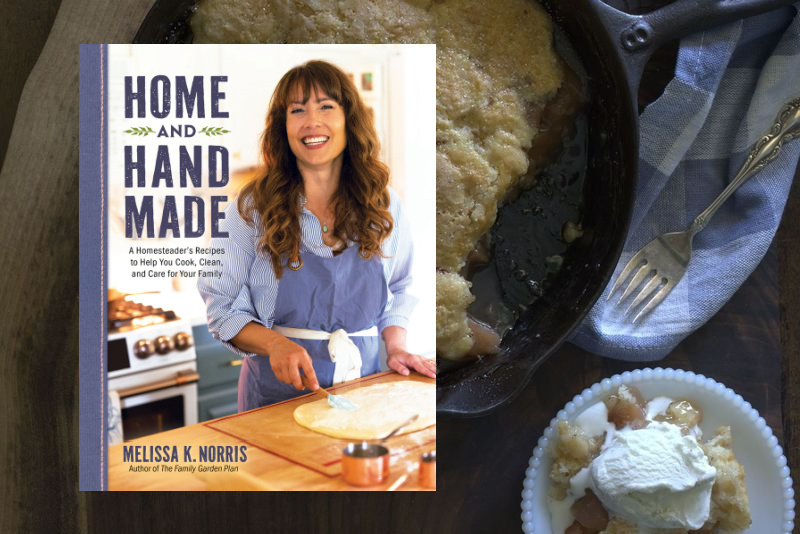
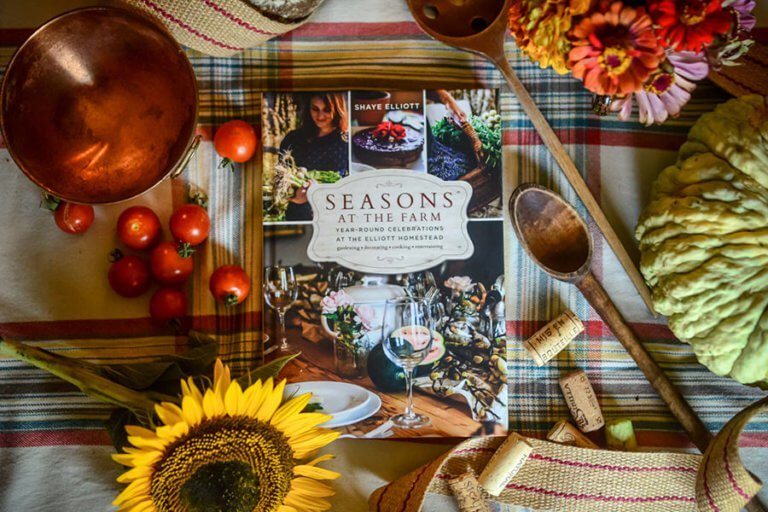
Seasons at the farm
Melissa: So, I love talking about seasons and, like I said, spring is one of my favorites, but you have a book specifically called Seasons At The Farm. So talk to me a little bit about your book.
Shaye: This book was born out of this idea that a homestead has to be ugly, because I just really pushed back against that idea and I wanted the book to show that functionality and beauty can coexist.
We have a working farm. We have dairy cows that we milk every day. We raise our animals for meat. We raise our food for the year. But it was equally important to me that it looked beautiful; That it was an inspiring place to be and create for us and for our children. So this book was sort of born out of that idea. And so it’s really a reflection on what each season has to offer on the farm and how we celebrate that in the everyday moments, from what we eat to how we decorate our home, to what we’re doing outside to what’s growing, etc.
We often have these small highlighted moments in our life, you know, when maybe when we get married or when we have children or when we land the job we’ve always wanted or whatever it may be. But the majority of our life is just spent doing normal, everyday things. And one of the reasons that we’ve worked so hard to build this farm and to build this way of life is because I think that a Monday morning when you’re having a good espresso, sitting next to a fresh bouquet of daffodils, reading a good book on gardening, I think that’s just as much to celebrate as climbing a mountain or landing a back flip on a jet ski or whatever it is that you’re into.
When you’re connected to the seasons, when you’re connected to the garden and to your home, you have this unique opportunity to bask in that and to add this intentional beauty and appreciation to your everyday life. And so this book was written with the hopes of inspiring other people to see that, to see that even in the mundane February gray days, what beauty is there to behold? What’s there for enjoyment?
Melissa: Can you highlight a couple of things that are featured in the book for spring?
Shaye: There’s an asparagus recipe in the book that we wrap up with bacon and we make these little bundles and it’s absolutely fantastic.
In the spring we’re also lambing and we have baby ducks that are wandering around the potager and chickens that are sitting on a big nest of eggs. And then of course in the garden we’re planting out all of our seedlings and we’re harvesting our first green peas and our spinach and we’re preparing those. So it’s a bustling time of year on the farm.
This time of year we’re just outside, sunup to sundown. I love, it recharges my soul after a long winter.
Melissa: Amen. Thank you so much for coming on today!
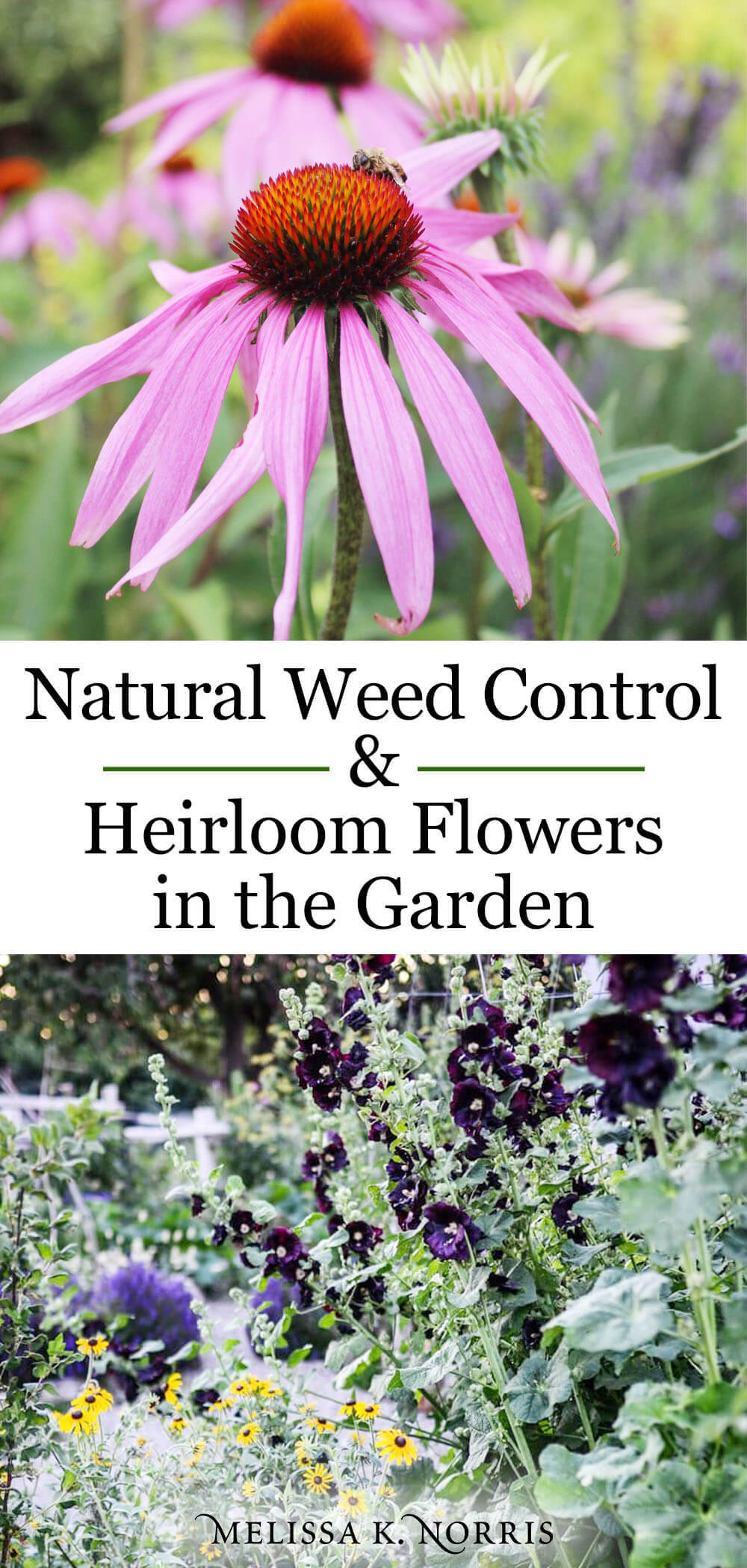
Shaye: Thanks for having me. Happy Gardening!
For further information on heirloom gardening, check out these articles as well!
List of Heirloom Varieties to Grow in Your Garden
10 Unique Heirloom Vegetables to Grow in Your Garden
Why Heirloom Seeds Are My Favorite
How to Save & Store Heirloom Seed
